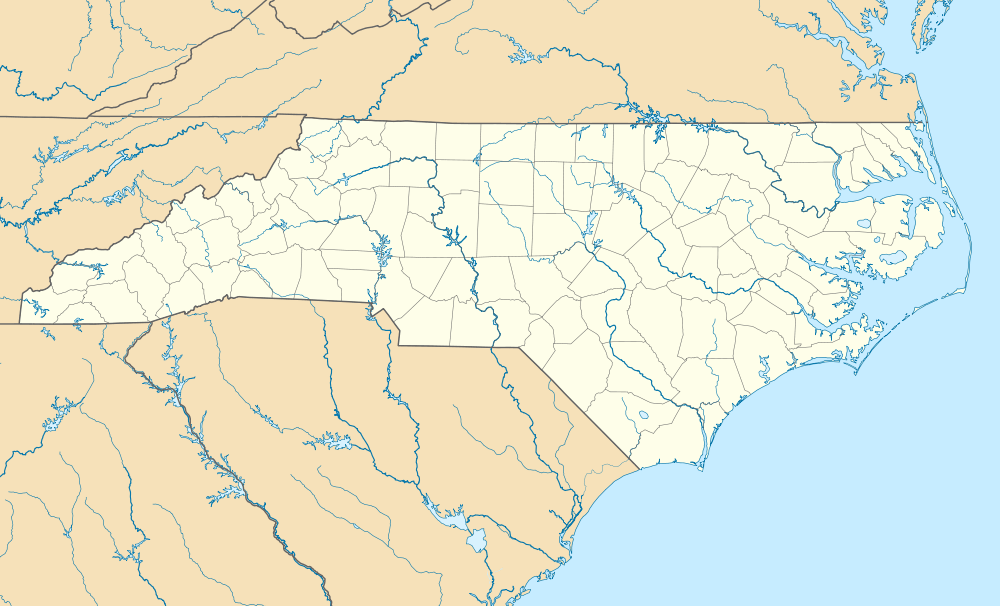Coolmore Plantation
Coolmore Plantation, also known as Coolmore and the Powell House, is a historic plantation house located near Tarboro, Edgecombe County, North Carolina. Built in 1858-61, the main house is one of the finest Italianate style plantation houses in the state. The house and its similarly-styled outbuildings were designed by Baltimore architect E. G. Lind for Dr. Joseph J.W. and Martha Powell. Coolmore was designated a National Historic Landmark for its architecture in 1978, and is a Save America's Treasures projects.
Coolmore Plantation | |
.jpg) Coolmore in 1940 | |
  | |
| Location | North Carolina Highway 3 (ALT United States Highway 64), west of Tarboro, North Carolina |
|---|---|
| Coordinates | 35°55′26″N 77°35′40″W |
| Area | 24.4 acres (9.9 ha) |
| Built | 1859 |
| Architect | E.G. Lind |
| Architectural style | Italianate |
| NRHP reference No. | 71000581 |
| Significant dates | |
| Added to NRHP | February 18, 1971[1] |
| Designated NHL | June 2, 1978[2] |
Description and history
Coolmore is located west of Tarboro, on the south side of ALT United States Route 64 east of McNair Road. Set on a curving drive, the main house is a two-story wood frame structure, with single-story wings to either side. Its roof is hipped, but there are gabled projections with wide overhanging eaves supported by elaborately cut brackets. First-floor windows are paired narrow rectangular sash, set in segmented-arch openings with molded bracketed hoods, while second-floor windows are paired round-arch sash. The interior is divided into elaborately decorated and unusually shaped chambers. At its center is a freestanding elliptical staircase. One of the downstairs parlors features a high-quality trompe-l'œil mural on the ceiling. Outbuildings with similar exterior styling include servants quarters, smokehouse, and a carriage house, all of which sport cupolas similar to that on the main house.[3]
The property was donated to Preservation North Carolina in the early 1990s. Opening Coolmore to the general public at this time is not realistic, due to the fragility of its signature oval stairwell, Trompe-l'œil paneling, elaborate plasterwork, and decorative painting. So the property has been leased long-term to resident curators, direct descendants of the original builder who open it periodically by appointment and take care of routine operating and capital needs. Preservation North Carolina has taken responsibility for developing a conservation plan for the property and for dealing with the extensive artwork in the main house. An endowment for the property has been started at the North Carolina Community Foundation to help with Coolmore's long-term care.
Coolmore was listed on the National Register of Historic Places in 1971 and declared a National Historic Landmark in 1978.[2][3]
See also
References
- "National Register Information System". National Register of Historic Places. National Park Service. January 23, 2007.
- "Coolmore Plantation". National Historic Landmark summary listing. National Park Service. Archived from the original on 2007-03-02. Retrieved 2008-02-23.
- J. G. Zehmer and John B. Wells (October 5, 1970). "National Register of Historic Places Inventory-Nomination: Coolmore Plantation" (pdf). National Park Service. Cite journal requires
|journal=(help) and Accompanying three photos, exterior and interior, from 1940, 1970, and 1972 (32 KB)
External links
| Wikimedia Commons has media related to Coolmore Plantation. |
- Preservation North Carolina Stewardship Properties
- Historic American Buildings Survey (HABS) No. NC-59, "Coolmore, U.S. Route 64, Tarboro, Edgecombe County, NC", 1 photo, 2 data pages
- Our State: Tarboro Tradition

